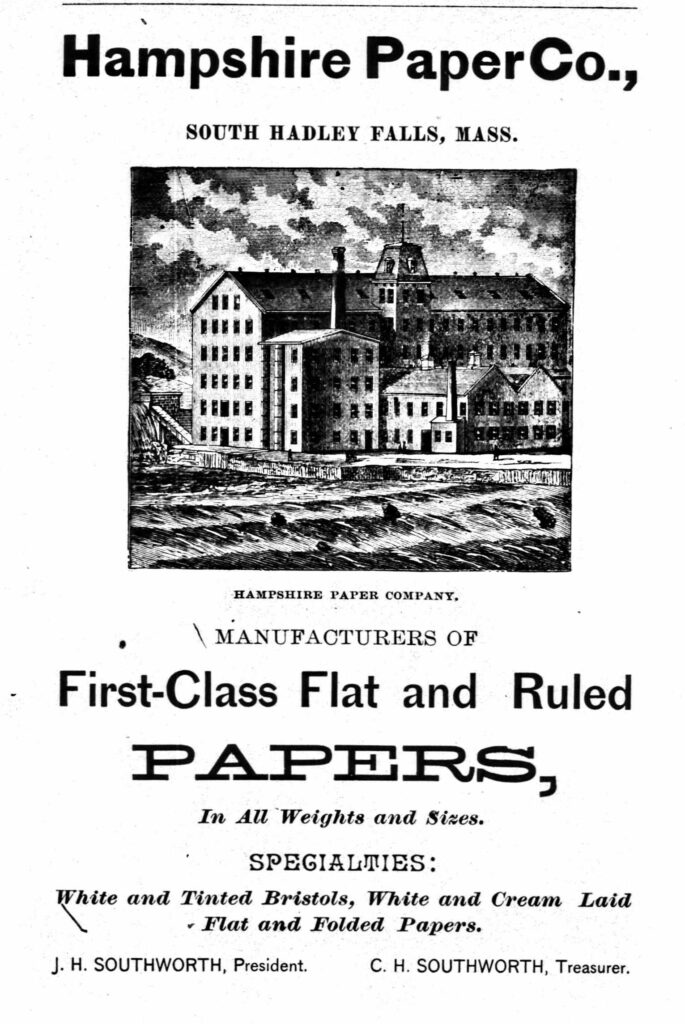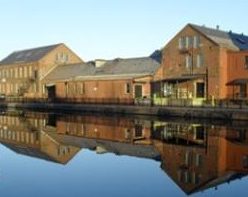This tour is described online by the Walking the Falls group = get a map in PDF format at the link to the left.
Leo Labonte describes the Canal in this VIMEO video.
Read a large HTT article from 1960 LINK and then one from 1949 LINK
- This is also part of the South Hadley Heritage tour. Navigate back to the tour page HERE.
- Private GROUP TOUR (COSTS) is two hours long for this Riverside Park to Canal Park walking tour.
- A free public tour comes up every year.
- VIDEO introduction to the tour
- A self-tour is available for anyone using the maps and text seen below. – LOCATION

stop 1 – Texon Park

Click on the link above to read about this stop. (LOCATION) The South Hadley Canal is the first canal for navigation on the continent. The only competitor to this claim is the Carondelet Canal. This canal was made in 1794 from Lake Pontchartrain in Louisiana to the Bayou Street Juncture in New Orleans. A two mile canal was dug at first at 15 feet wide. There was no locks on the system. The canal might have been used first in December of that year. The South Hadley Canal might have also been used in December of that year. The Carondelet was not in the territory of the United States yet. Thus the South Hadley Canal bets the Carondelet Canal in two aspects that of being within the United States has it was defined in 1794 and also in that it had a lifting mechanism.
The South Hadley Canal is one of six navigation canals along the Connecticut River. Read about this incredible system at the LINK.


The Carew Paper Mill was here from June 19 1848. The old navigation canal was redone so that it was both at the same time a navigation canal and a power canal. In 1873 their mill burned but it was rebuilt. The Carew lasted as a company until 1948. Texon took it over and they kept the building open until 1986.

Between Texon Park and Lower Riverside Park there was the Hampshire Paper Mill. This was built alongside the Carew in 1864. It lasted until 1935 when it finally closed. The Stevens Paper Mill moved into this mill in 1940 and kept it until 1968 when it razed the building two years later. A plan of the Stevens is HERE.

stop 2 – Gatehouse Park
Gatehouse Park (LOCATION) is only opened for special occasions. Notice that the two gatehouses are really old gatehouses with additions added to their tops. You can tell this by their brickwork. The westernmost of the two gatehouses was made in 1848 on top of the apron for the 1848 wooden dam. The easternmost gatehouse was put in place in 1900 but it is not on a plan of the 1900 masonry dam so it perhaps was an afterthought. The South Hadley Navigation Canal and the Bardwell Industrial Canal were combined in 1848 into one canal that served as both a power canal and a navigation canal. The 1848 wooden dam raised the river water enough so that the middle and northern portions of the South Hadley Navigational Canal were not needed. This dual use lasted until 1862 when the navigation ended. From then until 1977 the southern half of the canal was a power canal only.
stop 3 – Lower Riverside Park

(Click link to above for information.) In 1805 the Bardwell Canal and Dam were built in this place. (LOCATION) It fed water into the small mills that lined the banks. These were small sawmills and gristmills. There were about 11 such mills at one time.
| number | type | product | name |
| 1 | saw mill | cut logs | Philip Smith |
| 2 | grist mill | ||
| 3 | plaster mill | grounded rocks | Zenas Church |
| 4 | oil mill | cotton and flaxseed | Obed Carpenter |
| 5 | shingle mill | sliced logs | Philip Smith |
| 6 | wool mill | carding wool and coloring cloth | Asa Nash |
| 7 | |||
| 8 | |||
| 9 | |||
| 10 | Howard and Lathrop Paper Mill | ||
| 11 | Ames Paper Mill |
The Howard and Lathrop Paper Mill started here in 1824 and lasted until a fire in 1846. From 1824 to 1846 the Ames Paper Mill was here. The Ames made the first device that mass produced paper. Ames was northeast of the Howard and Lathrop by a bit. In 1848 the Glasgow Gingham Mill was built here. It lasted until 1896 when it closed due to lack of profit. The Hadley Mill of Holyoke purchased all in 1903 and lasted until 1930. Then Holyoke Water Power bought it and razed it in 1935.
stop 4 – Lock System

The lock system of the South Hadley Canal (LOCATION) was once 375 feet long. It was in five sections. Each section had its own pump to add water to the lock. The entrance into the lock system is south of the Vietnam Veterans Bridge.
stop 5 – North Main Street Architecture
Up North Main Street (LOCATION) you can see the start of many nice buildings. The Fire House Museum is on the left. On the right is the Masonic Temple plus two churches.
The toll gatherers house is up the road. List of toll collectors.
stop 6 – High Street Architecture
Glasgow Workers’ Homes line the eastern side of High Street. (LOCATION) There are 12 buildings that were made in the same format. The only house in that line that is different used to be a store and a post office.
The list of the postmaster in South Hadley Canal or Falls is at the link POSTMASTERS
stop 7 – South Hadley Library (Click link to the left for information.)
VIDEO and Panoramic Video
stop 8 – Canal Street Architecture
17 Canal Street is Carew Workers Housing from 1860.
stop 9 – Hadley Falls Bicentennial Park


When you are on the deck at the Hadley Falls Park (LOCATION), look sharp to your right along the riverbank. The watercourse that is along the river at this point is the cove portion of Cove Island. It is not the South Hadley Canal yet. We will go down to the canal. Along the way you will pass a memorial to John Kuzma. He died in Vietnam in 1966 and is buried in the South Hadley Falls Cemetery.
stop 10 – South Hadley Canal

Walk north along Canal Street a bit more. There is a concrete block that had a metallic map of the canal system on its top. Follow the trail north into the woods. (LOCATION) The canal is at the end of this path. Finally you can see remnants of the South Hadley Canal. You can see Cove Island out in the water.

stop 11 – Inclined Plane and Lock System

Walk farther down the path and you will find another information stop. This one explains the Incline Plane and the lock system. The canal is about half way through its 2.5 miles length. You can keep walking along the tow path for a half mile or so. There is even a path on the other side that you can walk on.
stop 12 – Canal Boats

Canal boat were flat bottomed boats that held the cargo ships on their tops. Men or horses would pull the boats up or down this navigational canal. Pilots on calm days would navigate the canal/ The captain of a boat was not allowed to navigate the canal themselves but rather were required to have the canal pilot do it. From the end of the central part of the canal it is another mile to the northern start of the South Hadley Canal. To get there drive north on Canal Street and take a right onto West Summit Drive. Then take a left onto North Main Street. Take the first left onto River Road. Drive for about a mile until you reach the Locktender’s House at 315 River Road.

This for use by the locktender of the canal. Here were two more locks that raised the boats to the height of the canal water.





